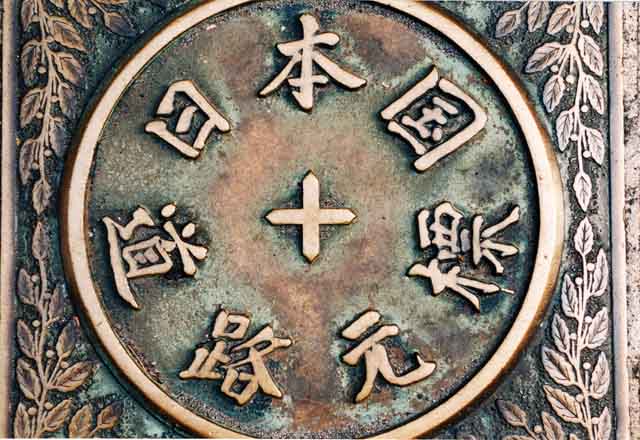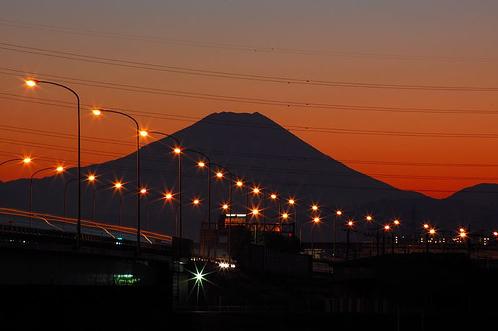Kōshū Kaidō on:
[Wikipedia]
[Google]
[Amazon]
 The was one of the five routes of the
The was one of the five routes of the
. Shinjuku City Office. Accessed November 28, 2007. Many feudal lords from
. Yumekaidō. Accessed September 4, 2007.
. NEC Corporation. Accessed August 4, 2007. They are listed below with they corresponding modern-day municipality listed in

 :Starting Location: Nihonbashi ( Chūō)
:1. Naitō Shinjuku (内藤新宿) (
:Starting Location: Nihonbashi ( Chūō)
:1. Naitō Shinjuku (内藤新宿) (
 :42. Tsutaki-shuku (蔦木宿) ( Fujimi, Suwa District)
:43. Kanazawa-shuku (金沢宿) ( Chino)
:44. Kamisuwa-shuku (上諏訪宿) ( Suwa)
:Ending Location:
:42. Tsutaki-shuku (蔦木宿) ( Fujimi, Suwa District)
:43. Kanazawa-shuku (金沢宿) ( Chino)
:44. Kamisuwa-shuku (上諏訪宿) ( Suwa)
:Ending Location:
Information on the 44 Stations of the Kōshū Kaidō
{{DEFAULTSORT:Koshu Kaido Road transport in Japan Edo period
 The was one of the five routes of the
The was one of the five routes of the Edo period
The or is the period between 1603 and 1867 in the history of Japan, when Japan was under the rule of the Tokugawa shogunate and the country's 300 regional '' daimyo''. Emerging from the chaos of the Sengoku period, the Edo period was characteriz ...
. It was built to connect Edo (modern-day Tokyo
Tokyo (; ja, 東京, , ), officially the Tokyo Metropolis ( ja, 東京都, label=none, ), is the capital and largest city of Japan. Formerly known as Edo, its metropolitan area () is the most populous in the world, with an estimated 37.468 ...
) with Kai Province in modern-day Yamanashi Prefecture
is a prefecture of Japan located in the Chūbu region of Honshu. Yamanashi Prefecture has a population of 817,192 (1 January 2019) and has a geographic area of 4,465 km2 (1,724 sq mi). Yamanashi Prefecture borders Saitama Prefecture to the ...
, Japan
Japan ( ja, 日本, or , and formally , ''Nihonkoku'') is an island country in East Asia. It is situated in the northwest Pacific Ocean, and is bordered on the west by the Sea of Japan, while extending from the Sea of Okhotsk in the north ...
. The route continues from there to connect with the Nakasendō
The , also called the ,Richard Lane, ''Images from the Floating World'' (1978) Chartwell, Secaucus ; pg. 285 was one of the five routes of the Edo period, and one of the two that connected Edo (modern-day Tokyo) to Kyoto in Japan. There were 6 ...
's Shimosuwa-shuku was the twenty-ninth of the sixty-nine stations of the Nakasendō, as well as being the ending location of the Kōshū Kaidō. It is located in the present-day town of Shimosuwa, Suwa District, Nagano Prefecture, Japan.
History
First built arou ...
in Nagano Prefecture
is a landlocked prefecture of Japan located in the Chūbu region of Honshū. Nagano Prefecture has a population of 2,052,493 () and has a geographic area of . Nagano Prefecture borders Niigata Prefecture to the north, Gunma Prefecture to the ...
.Information on Everyday Living for Foreign Residents of Shinjuku City. Shinjuku City Office. Accessed November 28, 2007. Many feudal lords from
Shinano Province
or is an old province of Japan that is now Nagano Prefecture.
Shinano bordered on Echigo, Etchū, Hida, Kai, Kōzuke, Mikawa, Mino, Musashi, Suruga, and Tōtōmi Provinces. The ancient capital was located near modern-day Matsumoto, whi ...
made use of the road during ''sankin-kōtai
''Sankin-kōtai'' ( ja, 参覲交代/参覲交替, now commonly written as ja, 参勤交代/参勤交替, lit=alternate attendance, label=none) was a policy of the Tokugawa shogunate during most of the Edo period of Japanese history.Jansen, M ...
'', including those from the Takatō, Suwa and Iida domains.
The Kōshū Kaidō's route is followed closely by the modern Route 20.
Stations of the Kōshū Kaidō
There are 44 post stations along the Kōshū Kaidō.Kōshū Kaidō Map. Yumekaidō. Accessed September 4, 2007.
. NEC Corporation. Accessed August 4, 2007. They are listed below with they corresponding modern-day municipality listed in
parentheses
A bracket is either of two tall fore- or back-facing punctuation marks commonly used to isolate a segment of text or data from its surroundings. Typically deployed in symmetric pairs, an individual bracket may be identified as a 'left' or 'r ...
.
Tokyo

Shinjuku
is a special ward in Tokyo, Japan. It is a major commercial and administrative centre, housing the northern half of the busiest railway station in the world (Shinjuku Station) and the Tokyo Metropolitan Government Building, the administration ...
)
:2. Shimotakaido-shuku (下高井戸宿) ( Suginami)
:3. Kamitakaido-shuku (上高井戸宿) (Suginami)
:4–8: Fuda-Goshuku(布田五宿): These small posts are collectively referred to as Fuda-Goshuku. 'Goshuku' means five post-stations in Japanese.
::4. Kokuryō-shuku (国領宿) (Chōfu
is a city in the western side of Tokyo Metropolis, Japan. , the city had an estimated population of 238,087, and a population density of 11,000 per km². the total area of the city is .
Geography
Chōfu is approximately in the south-center of ...
)
::5. Shimofuda-shuku (下布田宿) (Chōfu)
::6. Kamifuda-shuku (上布田宿) (Chōfu)
::7. Shimoishihara-shuku (下石原宿) (Chōfu)
::8. Kamiishihara-shuku (上石原宿) (Chōfu)
:9. Fuchū-shuku (府中宿) ( Fuchū)
:10. Hino-shuku (日野宿) ( Hino)
:11. Hachiōji-shuku (八王子宿) (Hachiōji
is a city located in the western portion of Tokyo Metropolis, Japan. , the city had an estimated population of 561,344, and a population density of 3000 persons per km2. The total area of the city is .
Geography
Hachiōji is located in the ...
)
:12. Komagino-shuku (駒木野宿) (Hachiōji)
:13. Kobotoke-shuku (小仏宿) (Hachiōji)
Kanagawa Prefecture
:14. Ohara-shuku (小原宿) (Sagamihara
is a city in Kanagawa Prefecture, Japan. , the city has an estimated population of 723,470, with 334,812 households, and a population density of 1,220 persons per km2. The total area of the city is . Sagamihara is the third-most-populous city ...
)
:15. Yose-shuku (与瀬宿) (Sagamihara)
:16. Yoshino-shuku (吉野宿) (Sagamihara)
:17. Sekino-shuku (関野宿) (Sagamihara)
Yamanashi Prefecture
:18. Uenohara-shuku (上野原宿) (Uenohara
is a city located in Yamanashi Prefecture, Japan. , the city had an estimated population of 23,158 in 9987 households, and a population density of 140 persons per km². The total area of the city is .
Geography
Uenohara is located in the extre ...
)
:19. Tsurukawa-shuku (鶴川宿) (Uenohara)
:20. Notajiri-shuku (野田尻宿) (Uenohara)
:21. Inume-shuku (犬目宿) (Uenohara)
:22. Shimotorisawa-shuku (下鳥沢宿) (Ōtsuki Ōtsuki may refer to:
*Ōtsuki, Yamanashi, a city in Yamanashi Prefecture, Japan
*Ōtsuki Station, a railway station in Ōtsuki, Yamanashi, Japan
*Ōtsuki, Kōchi
270px, Ōtsuki Town Hall
is a town in the Hata District, Kōchi Prefecture, Jap ...
)
:23. Kamitorisawa-shuku (上鳥沢宿) (Ōtsuki)
:24. Saruhashi-shuku (猿橋宿) (Ōtsuki)
:25. Komahashi-shuku (駒橋宿) (Ōtsuki)
:26. Ōtsuki-shuku (大月宿) (Ōtsuki)
:27. Shimohanasaki-shuku (下花咲宿) (Ōtsuki)
:28. Kamihanasaki-shuku (上花咲宿) (Ōtsuki)
:29. Shimohatsukari-shuku (下初狩宿) (Ōtsuki)
:30. Nakahatsukari-shuku (中初狩宿) (Ōtsuki)
:31. Shirano-shuku (白野宿) (Ōtsuki)
:32. Kuronoda-shuku (黒野田宿) (Ōtsuki)
:33. Komakai-shuku (駒飼宿) ( Kōshū)
:34. Tsuruse-shuku (鶴瀬宿) (Kōshū)
:35. Katsunuma-shuku (勝沼宿) (Kōshū)
:36. Kuribara-shuku (栗原宿) ( Yamanashi)
:37. Isawa-shuku (石和宿) (Fuefuki
270px, Ichinomiya Asama Shrine
is a city in Yamanashi Prefecture, Japan. , the city had an estimated population of 69,463 in 29,406 households, and a population density of 340 persons per km2. The total area of the city is .
Geography
Fuefuki is ...
)
:38. Kōfu-shuku (甲府宿) (Kōfu
is the capital city of Yamanashi Prefecture, Japan. , the city had an estimated population of 187,985 in 90,924 households, and a population density of 880 persons per km2. The total area of the city is .
Overview Toponymy
Kōfu's name means " ...
)
:39. Nirasaki-shuku (韮崎宿) ( Nirasaki)
:40. Daigahara-shuku (台ヶ原宿) ( Hokuto)
:41. Kyōraiishi-shuku (教来石宿) (Hokuto)
Nagano Prefecture
 :42. Tsutaki-shuku (蔦木宿) ( Fujimi, Suwa District)
:43. Kanazawa-shuku (金沢宿) ( Chino)
:44. Kamisuwa-shuku (上諏訪宿) ( Suwa)
:Ending Location:
:42. Tsutaki-shuku (蔦木宿) ( Fujimi, Suwa District)
:43. Kanazawa-shuku (金沢宿) ( Chino)
:44. Kamisuwa-shuku (上諏訪宿) ( Suwa)
:Ending Location: Shimosuwa-shuku was the twenty-ninth of the sixty-nine stations of the Nakasendō, as well as being the ending location of the Kōshū Kaidō. It is located in the present-day town of Shimosuwa, Suwa District, Nagano Prefecture, Japan.
History
First built arou ...
(Shimosuwa
is a town located in Nagano Prefecture, Japan. , the town had an estimated population of 20,055 in 8864 households, and a population density of 300 persons per km². The total area of the town is .
Geography
Shimosuwa is located in central Na ...
, Suwa District) (also part of the Nakasendō
The , also called the ,Richard Lane, ''Images from the Floating World'' (1978) Chartwell, Secaucus ; pg. 285 was one of the five routes of the Edo period, and one of the two that connected Edo (modern-day Tokyo) to Kyoto in Japan. There were 6 ...
)
See also
*Edo Five Routes
The , sometimes translated as "Five Highways", were the five centrally administered routes, or ''kaidō'', that connected the ''de facto'' capital of Japan at Edo (now Tokyo) with the outer provinces during the Edo period (1603–1868). The mos ...
** Tōkaidō (or 53 Stations of the Tōkaidō
The are the rest areas along the Tōkaidō, which was a coastal route that ran from Nihonbashi in Edo (modern-day Tokyo) to Sanjō Ōhashi in Kyoto.. There were originally 53 government post stations along the Tōkaidō, where traveler ...
)
**Nakasendō
The , also called the ,Richard Lane, ''Images from the Floating World'' (1978) Chartwell, Secaucus ; pg. 285 was one of the five routes of the Edo period, and one of the two that connected Edo (modern-day Tokyo) to Kyoto in Japan. There were 6 ...
(or 69 Stations of the Nakasendō
The are the rest areas along the Nakasendō, which ran from Nihonbashi in Edo (modern-day Tokyo) to Sanjō Ōhashi in Kyoto.Yama to Keikoku Publishing (2006). Nakasendō o Aruku (Revised ed.). Osaka: Yama to Keikoku Publishing. .Ōshū Kaidō
The was one of the five routes of the Edo period. It was built to connect Edo (modern-day Tokyo) with Mutsu Province and the present-day city of Shirakawa, Fukushima Prefecture, Japan. It was established by Tokugawa Ieyasu for government of ...
**Nikkō Kaidō
The was one of the five routes of the Edo period and it was built to connect Edo (modern-day Tokyo) with the temple-shrine complex of the Mangan-ji and Tōshōsha (now called the Rinnō-ji and Tōshōgū), which are located in the present-day ...
References
External links
Information on the 44 Stations of the Kōshū Kaidō
{{DEFAULTSORT:Koshu Kaido Road transport in Japan Edo period